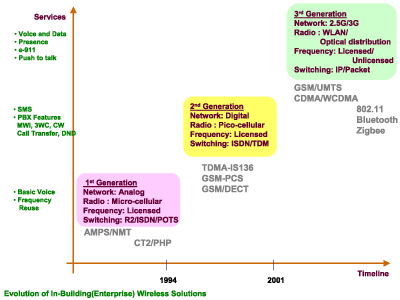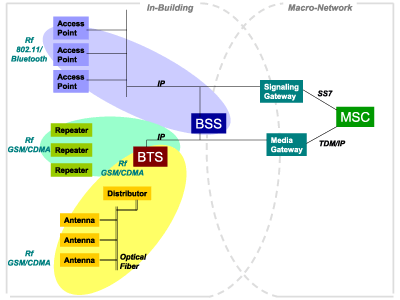Wireless in the enterprise
created a buzz in the last decade and fell short of expectations. Emerging
silently however, is the next generation of in-building wireless that has
all the ingredients to produce a winner. We circumspect at an exciting
prospect of seeing a billion dollar industry take shape with
cost-effective infrastructure spun from IP, VoWLAN and Optical RF
distribution technologies, about what is new and better this time.
But to shrug off the
skepticism of the wireless operators that have long waited for the promise
is not going to be easy. Let's take a quick look at the evolution of the
in-building wireless solution. We see three generations of in-building
wireless that align themselves well to the macro-cellular environments
that they augment.

Historically the challenges
that in-building wireless had set to solve were seamless coverage
indoors and more effective utilization of network bandwidth. In the early
days of analog cellular, coverage in building tended to get spotty and
thats when solutions of using micro-cellular base stations could help in
providing better coverage at a lower infrastructure cost. So FDMA systems
such as CT2 and PHP filled in. The PBX world also saw an opportunity and
took initiatives to wirelessly enable their PBXs with radio systems.
Motorola, Ericsson, Siemens and Mitel came out with their solutions during
this time.
However, the meteoric rise of TDMA/GSM systems stunted these systems. This started the
digital
generation and the broad concept was to provide picocellular support via
the same public frequency or frequency reuse. So for TDMA networks, it was
IS-136 for both outdoor and indoor. GSM networks used GSM for indoors as
well or a variant -- DECT for the in-building coverage. Systems such as the
Ericsson-MobileAdvantage, Hughes-WOS, AGCS-Roameo and Cisco-MNET came
close to delivering great promise but did not sustain.
SO WHAT IS DIFFERENT NOW?
While the networks
are converging with GSM and CDMA with the 3G rollouts, the actual impetus
has come from the proliferation of both IP and the access technology for
wireless LAN access. That encompasses the technologies gaining momentum: WiFi/WiMax, Bluetooth and Zigbee. So conceptually, while all the
in-building wireless generations all have similarities, the current
in-building wireless generation has by far the greatest asset. That is low
infrastructure cost.
Traditionally, in-building
wireless systems have faced the following challenges:
-
Infrastructure costs, while
lower than establishing macro-cellular coverage, were substantially
high;
-
Integrating with TDM
switching was not easy technically or financially;
-
Although the value
proposition was well understood, the revenue model for the operators was
not clearly understood; and
-
Frequency reuse and use of
the licensed spectrum was an inhibitor for smaller players to get into
the game.
Although operators are still
waiting for the solutions to mature, it is clear that the new breed is
here to shape a new generation of in-building wireless.
MARKET TRENDS
While the market has
got a boost from the recent funding of startup companies such as Kineto
Wireless ($24M) and RadioFrame Networks ($12M), this validation has given
a boost to innovative companies rather than the major wireless players.
The market dynamics seem to be settling into two groups of technologies
that are active or passive entities in the service network. The entities
range from basic repeaters, distributed antenna systems and access points.
The equipment makers in this space are Andrew Wireless, LGC
Communications, MobileAccess and Spotwave to name a few.
ABI Wireless gives a promising
forecast of the market to grow to about $1.3B by 2009.
EXCITING TECHNOLOGIES BUILDING
UP
The impact of IP in
the enterprise has been the primary impetus for a lowered infrastructure
cost. The promise to further enable wireless LANs with 802.11/Bluetooth
broadband solutions has brought wireless access to the desktop. This is
leading to further lowering of both capex and opex in the enterprise. The
integration of optical technology into RF distribution provides an elegant
solution to the spotty RF coverage problem even for the licensed public
frequency bands. Both WLAN access points and RF-distributors offer a much
greater promise over a micro/pico-cellular solution.
VoIP is here to stay and VoWLAN
is not far behind. All eyes are on 802.11e to reduce the latency/jitter
issues.
The other trend that is taking
place is the connectivity to the macro-cellular network. While the
second-generation systems would appear as an MSC to the macro-cellular MSC, the
operators did not favor this approach. A WOS network was an isolated
network private to a control of the MSC and that required allocation of
point-codes for each that are not visible to the rest of the cellular
network. A signaling gateway to provide this point code isolation solved
that challenge. But the issue of providing service interoperability such
as voice mail at two locations remained a challenge. However the trend is
aligning towards the 3GPP-R4/R5 architecture. A wireless office connects
as a BSC or a RAN to the macro-cellular network and connectivity is purely
via IP.

SERVICES REMAIN THE KEY
DIFFERENTIATOR
In a typical
scenario, driving on her way to work, Kathy receives a call on her
handheld device -- a PDA phone. Russ needs to close a deal in the next hour
and
needs a commitment for an additional 400 power supplies delivered by
Friday. Walking towards the elevator, Kathy puts him on hold, checks her
co-worker buddy list and pushes to talk to Mike, her assembly line
manager. Mike, who is currently away from his desk, tells her they can and
sends her the current assembly line utilization data. Kathy takes a quick
look and gives a green signal. The deal is done.
No phone tag, no paging, less
voice mail and higher productivity. A single device, a single number and a
follow-me service. And little did Kathy and Russ realize that as soon as
Kathy walked into her office building, the call handed off seamlessly from
the CDMA network to Bluetooth and behind the scenes SIP enabled further
conversation with Mike.
While the first generation did
not even support Caller ID, message waiting and SMS, 2G introduced a rich
feature set to the users. This was a blend of best-of-breed services from
the cellular network as well as the PBX. So, for instance, a do-not-disturb
feature for the handset and call transfers between a handset and deskset
became a reality.
But now voice holds little
novelty. The new generation has to provide a seamless execution of both
voice and data and very soon multimedia services as well. Corporate usage
of IM has increased and services that include presence and push-to-talk
are required for support in this generation as well.
More challenging are the
mandates for E-911 location tracking that have to be supported. The
current generation of in-building wireless systems offers an added degree
of accuracy to location tracking, which is namely the third dimension. An
E-911 call today from a 50-story high-rise can pinpoint the street
address, but not beyond.
Seamless mobility, total
coverage and a feature-rich service are the key forces to propel mere
access technologies to realize the great wireless dream in the enterprise.
This concept is nothing new, but seems to be getting better as it ages and
this time the timing and drivers seem to have it right. This will remain
the differentiator between enterprise wireless solutions.
For more information visit
www.intellinet-tech.com.
Arun Handa is vice president of product management at IntelliNet
Technologies, Inc. IntelliNet is a provider of high quality
telecommunications solutions for both emerging wireless and wireline
industries. IntelliNet's application development software significantly
reduces the development and deployment time for 2.5G, 3G and IN
applications, and the services they support. With expertise in SS7,
SIGTRAN, and IP, along with extensive application development experience,
IntelliNet's unique value lies in the ability to insulate application
developers from the low-level intricacies of telecommunication signaling
foundation technologies.
|